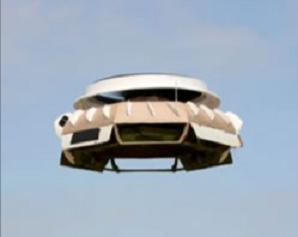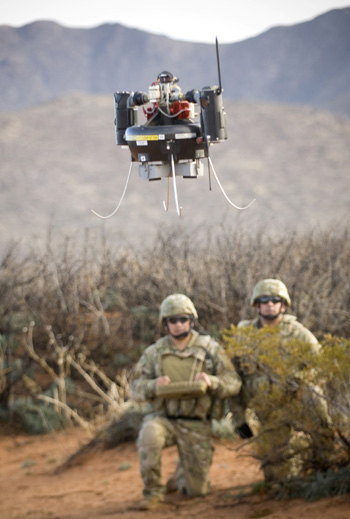This article is more than 1 year old
Brit firm to demo serious flying robo-saucer in 2009
Peterborough Attacks
A small British company developing a unique form of hovering aircraft says it will soon demonstrate a new and much more serious version of its technology.

Saucer technology in action.
GFS Projects of Peterborough was registered in 2002, following early efforts by former hovercraft engineer Geoff Hatton to develop a working "flying saucer" aircraft based on the Coanda effect. (GFS stands for Geoff's Flying Saucers.) The Reg spoke to GFS marketing chief Mark Broughton this morning, who gave us a run-through on the "Fenstar 50" autonomous unmanned saucer which the company hopes to have flying in the first half of next year.
Firstly, the Fenstar 50 will be the first GFS saucer to use an internal combustion engine. Previous craft have been electrically powered, and have suffered from very short endurance. The current electric saucer, which formed part of Team MIRA at the recent MoD "Grand Challenge" ambush-sniffing tech contest, can normally stay up for just two and a half minutes. The new Fenstar 50 is expected to manage up to an hour, carrying a payload of 5kg - a quarter of its all-up weight. GFS aims to keep the total weight under 20kg, as this is the most that the CAA allows under model aircraft rules. Any more would take the company into the hugely more onerous certification regime for full-sized aircraft.
Even at 20kg, however, the Fenstar 50 will be significantly bigger and more capable than one of its main rivals, the Micro Air Vehicle (MAV) from Honeywell. The MAV uses a ducted fan rather than a GFS-style Coanda surface, but this offers similar advantages - neither vehicle has projecting helicopter-style rotors. Both of them can thus fly about happily in between buildings, and perhaps in and out of doors and windows etc. Both could be very useful as reconnaissance machines for soldiers, especially in dangerous urban combat - indeed Honeywell's machine has already seen action in Iraq. The MAV runs on a two-stroke petrol engine like the Fenstar, and offers similar endurance, though it weighs just 7.25 kg and can barely lift a pair of cameras.

The US version. Overpaid, oversexed, overhead.
GFS' Broughton reckons the Coanda saucer is better than ordinary ducted fans, being more stable and easily controllable. According to people who have seen both, the GFS platform offers a "much more stable" video image than the MAV (GFS received a small tech-demo contract from the US military recently).
Broughton was also keen to point out that, while the electric GFS machine didn't actually compete at the MoD Grand Challenge, this was "purely because of bad weather conditions" rather than any technical issue - though admittedly the short endurance might have limited its contribution had it got stuck in.
Asked if he thought GFS could win future military/security business in the States, Broughton said "we're ever hopeful. Even a small development deal over there can be $10m, easily - that would be very significant to us. But the MoD doesn't spread that kind of money around to develop new stuff."
We suggested that sometimes it does, in fact. Broughton said, "Yes, but we're not called BAE Systems."
Another hill for GFS to climb is the issue of autonomous control. The firm's saucers, rather than directing air straight down like a ducted fan, instead stream fan air over their curved upper surface. The fast airflow reduces pressure on the saucer top, allowing the normal air pressure beneath it to push it up. (Aircraft wings are also curved on top to make use of this effect, but in their case it is not the only factor in play - otherwise planes could never fly upside down.) The saucer controls rotation and side-to-side motion by means of cunning flaps and fins secured to the outer surfaces.
While Broughton says that the Coanda saucer tech provides a more easily-controlled platform than an ordinary ducted fan, it provides a unique problem for control software. Systems to let the saucers hover and move about autonomously - requiring no remote piloting - are essential if GFS is to become a serious contender. Hardware isn't an issue - the necessary actuators etc. are already in place for the remote controls, so Broughton expects no significant weight penalties. But it won't be possible to buy the software off the shelf, as one might with a small helicopter or fixed-wing plane - it will have to be custom built.
For the foreseeable future, GFS saucers seem fated to be unmanned. But there's hope for the flying-car fanciers yet. Asked if`there was any aspiration to scale the tech up to manned versions, Broughton emphatically replied: "Yes. In fact if you ask our chairman he'd say that's one of the reasons he's involved."
The jury's still out on whether Hatton's Coanda saucers are actually better than ducted fans - or indeed whether either will ever be mainstream flight technologies. But you have to like GFS for being willing to try something new. Rather than producing a duplicate rival to the Honeywell MAV and similar machines, they are offering altogether different technology which might actually be superior - breaking new ground rather than playing catch-up.
One has to say that it would make sense for the MoD to put some of its scarce R&D funds GFS' way - rather than giving BAE Systems plc huge, undisclosed sums to play catch-up and reinvent American wheels, as it's doing right now. ®
